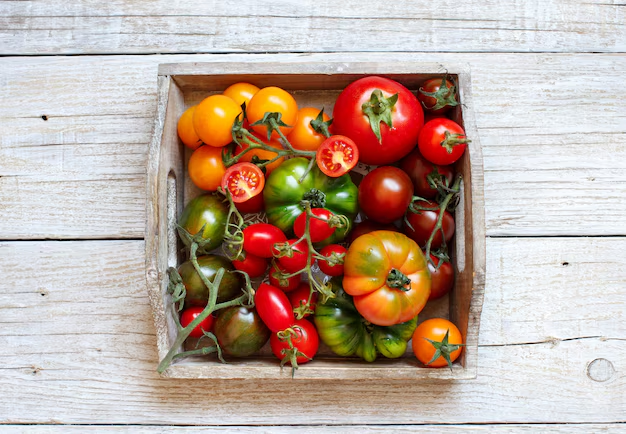Do Tomatoes Stay Fresher in the Refrigerator? Unlocking the Secrets of Tomato Storage! 🍅
Few things are as disappointing as reaching for a tomato only to find it mushy or spoiled. Whether you're a culinary enthusiast or simply enjoy a good salad, knowing how to store tomatoes can make a significant difference in both flavor and longevity. In this comprehensive guide, we’ll explore the timeless question: Do tomatoes last longer in the refrigerator? We’ll uncover the intricacies of tomato storage, delve into related topics like ripeness and preservation techniques, and offer practical advice to keep your tomatoes fresh longer.
🍽️ The Basics of Tomato Preservation
Before diving deep into specifics, it's crucial to understand the foundational concepts of tomato storage. Tomatoes are unique fruits, often caught in the crossroads between traditional fruit and vegetable categorizations—a fact that influences how they are stored.
The Ripeness Factor
Ripeness plays a vital role in determining the optimal storage method for tomatoes. When tomatoes are picked at peak ripeness, their flavors are full, but they become more delicate and prone to spoilage.
- Unripe Tomatoes: These should ideally ripen outside the refrigerator. This slow, natural process enhances sweetness and flavor—qualities often subdued by cold temperatures.
- Ripe Tomatoes: Once tomatoes have reached the desired ripeness, moving them to a cooler environment can help extend their lifespan.
🌡️ To Refrigerate or Not? Understanding the Cooling Conundrum
The debate over whether to refrigerate tomatoes hinges on several key factors, including their current ripeness, ambient storage conditions, and personal taste preferences.
Pros and Cons of Refrigeration
Refrigerating tomatoes has both its advocates and skeptics. Here are the strengths and shortcomings:
Pros:
- Prolonged Shelf Life: Refrigeration can significantly slow down the decay process for tomatoes that are already ripe.
- Reduced Spread of Decay: Cooler temperatures can prevent the rapid spread of any initial decay, maintaining tomato quality for a more extended period.
Cons:
- Flavor Loss: Many consumers report a noticeable loss in rich tomato flavor and texture when refrigerated, primarily due to the suppression of the natural ripening enzymes by the cold.
- Change in Texture: The cold can alter a tomato's texture, turning it mealy or mushy, particularly if stored for prolonged periods.
Practical Storage Tips
- Kitchen Counter Magic: For unripe tomatoes, a room temperature spot out of direct sunlight is optimal to allow natural ripening.
- Refrigerator Rescue: Only when tomatoes are fully ripe or overripe, consider refrigeration within a produce drawer to preserve freshness and prevent spoilage.
🛒 Beyond Storage: How to Choose the Best Tomatoes
How well tomatoes store often depends on their quality at purchase. Here’s how to select ideal tomatoes for immediate and extended use.
Key Selection Tips
- Firmness: Opt for tomatoes that gently yield to slight pressure but remain firm, suggesting they’re ripe without being overripe.
- Color: A vibrant, consistent color is indicative of ripeness and flavor.
- Smell: A sweet and earthy aroma near the stem bodes well for taste and quality.
🏡 Growing Your Own: Storage Starts Even on the Vine
For those indulging in home gardening, considering storage techniques right from the vine can yield results in both quality and preservation.
From Garden to Table
- Timing Harvests: Harvest at peak ripeness but before signs of over-ripening, which can prevent premature decay.
- Handling Gently: Avoid bruising by handling tomatoes gently as you harvest and transport them.
🛠️ Extending Freshness: Advanced Preservation Techniques
When you have an excess of tomatoes or if you wish to enjoy seasonal flavors year-round, various preservation methods can be implemented.
Canning and Freezing Techniques
- Canning: This involves sealing tomatoes in airtight containers at high temperatures, which can prevent microbial growth and allow long-term storage without refrigeration.
- Freezing: Ripe tomatoes can be diced, pureed, or blanched, then frozen to halt ripening, maintaining their nutrition and flavor for months.
Drying and Dehydration
Dehydrating tomatoes intensifies their flavors, removes excess water, and extends shelf life tremendously.
- Sun-Drying: Naturally drying tomatoes outdoors or in an oven is a popular method, albeit time-consuming, to lock in flavors.
- Dehydrators: A quicker method to efficiently remove moisture, preserving sweetness and nutrients.
🧑🍳 Cooking and Utilizing Refrigerated Tomatoes
Despite some degradation in texture, refrigerated tomatoes can still be culinary stars. Here are ways to bring out their best:
Recipes and Preparation Methods
- Soups and Sauces: Refrigerated tomatoes can show their vibrant taste in blended applications, such as soups or marinara sauces.
- Roasting: This method can enhance flavors, caramelizing their natural sugars for a robust taste.
- Salsas and Relishes: The firmness of refrigerated tomatoes holds up well in diced preparations enhanced with spices and herbs.
📋 Quick-Reference Tips for Tomato Storage and Use
Here’s an easily scannable guide to help you make the best storage decisions for your tomatoes:
- 🍅 Unripe Tomatoes: Store at room temperature away from direct sunlight.
- 🌡️ Ripe Tomatoes: Consider refrigeration if you don’t plan to use them within a couple of days.
- 🧑🌾 Home-Grown: Handle with care from the vine to prevent early spoilage.
- 🔄 Reviving: Use refrigerated tomatoes in soups or roasted dishes to elevate flavors.
- 💡 Preservation Alternatives: Consider canning or freezing for long-term storage.
🍴 Wrapping Up: Finding What Works for You
In the tomato storage journey, finding what works best comes down to personal preference as well as practical advice. Balancing between shelf life and taste, and understanding how conditions like temperature and ripeness affect these, empowers you to make informed decisions. Whether embracing the notion of room-temperature ripening or the cold-preserving embrace of the refrigerator, each technique has its place in the kitchen.
Embrace these storage strategies and savor the sweet, juicy delight of tomatoes whenever the culinary craving strikes!
